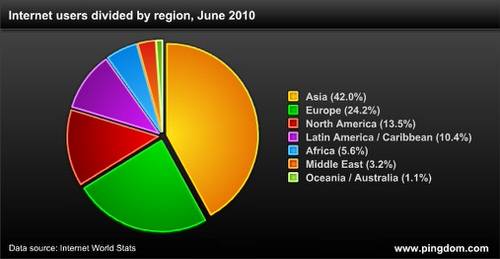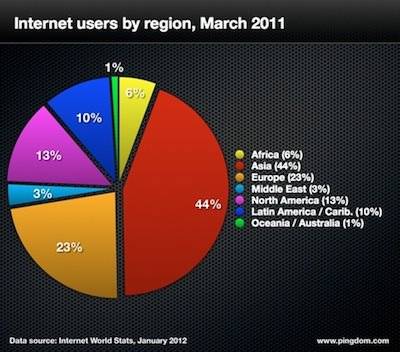Where were you on the Internet in 2010? What about in 2011? The folks over at Royal Pingdom have compiled a nice set of data for the Internet, by the Internet. That is, an entire list of data about email, websites, web servers, domain names by their .dot web addresses, Internet users by country, types of social media, web browser usage, mobile users, videos and images. We decided to take a look at the data points that tell us the most about the read/write web: websites and domain names, Facebook, Twitter and Internet users by continent. More importantly, we’ll look at how the Internet of 2011 compares to the Internet of 2010.

Facebook & Twitter: 2010 vs. 2011
Facebook: By the end of 2010, there were 600 million people total on Facebook, and 250 million were new users. Seventy percent of Facebook’s user base was located outside the United States. Users installed 20 million Facebook apps each day. Fast-forward one year later: 800+ million users on Facebook, including 200 million new users. By October 2011, Facebook was as big as the Internet of 2004. In 2011, Facebook mobile hit smartphones and Androids everywhere. Three-hundred fifty million Facebook users logged on from their mobile phones. They also shared 30 billion pieces of content (links, notes, photos) on Facebook every month. By the end of 2012, we’re likely to see an additional category: Facebook users who log on from their tablets, especially the iPad.
Twitter Loves @ladygaga: By the end of 2010, Twitter counted 25 billion sent tweets, 100 million new accounts and 175 million total users. Lady Gaga (@ladygaga) was Twitter’s most followed user, with a whopping 7.7 million followers. By the end of 2011, that number had more than doubled to 18.1 million followers – @ladygaga is still the world’s most followed Twitter user. Twitter grew to 225 million accounts, but only 100 million of those were active.
Tumblr and WordPress blogs grew fast in 2011. As of September 2011, Tumblr received 8X more pageviews than WordPress. By the end of the year, Tumblr blogs numbered 39 million and WordPress blogs hit 70 million.
Where Are The Internet Users? Asia
In 2010, Asia outnumbered all other continents with 42% of Internet users; in 2011, Asia made up 44% of the Internet’s population. European Internet users declined from 24.2% in 2010 to 23% by the end of 2011. North America saw a slight drop off, too, from 13.5% to 13%. Africa grew from only 5.6% of the Internet population to 6%. Latin America/Caribbean, Middle East and Oceania/Australia stayed about the same from 2010-2011.


Websites & Domain Names in 2010 vs. 2011
As of December 2010, the Internet held 255 million websites. That number more than doubled by the end of December 2011 to 555 million. Of domain name types, .COM grew the most from 88.8 million at the end of 2010 to 95.5 million by the end of 2011. The .NET domain names only grew by 0.6 million, whereas .ORG added 1.3 million domain names. The year 2011 also brought along 7.6 million .info domain names and 2.1 million .biz domains.
What will the Internet of 2012 look like? Post your predictions in the comments.





















